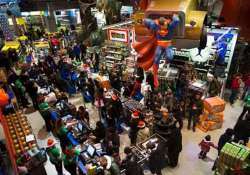Amid protests, US retailers open on Thanksgiving
New York: The U.S. holiday shopping season started even earlier Thursday, as more than a dozen major retailers opened on the Thanksgiving holiday despite protests from workers.The holiday openings are a break with tradition. The

New York: The U.S. holiday shopping season started even earlier Thursday, as more than a dozen major retailers opened on the Thanksgiving holiday despite protests from workers.
The holiday openings are a break with tradition. The day after Thanksgiving, called Black Friday, had been considered the official start to the holiday shopping season and the biggest shopping day of the year.
But in the past few years, retailers have pushed opening times into Thanksgiving night. They've also pushed up discounting that used to be reserved for Black Friday into early November.
Sales on Thanksgiving were $810 million last year, an increase of 55 percent from the previous year as more stores opened on the holiday, according to Chicago research firm ShopperTrak. But sales dropped 1.8 percent to $11.2 billion on Black Friday, though it still was the biggest shopping day last year.
Wal-Mart has been the biggest target for worker protests against holiday hours. Most of the company's stores are open 24 hours, but the retailer was starting its sales events at 6 p.m. Thursday, two hours earlier than last year.
Wal-Mart said workers get additional holiday pay for working on Thanksgiving. The company is also serving meals at the stores.
But worker Cindy Murray, 57, said she won't be able to sit down for a Thanksgiving meal with her family until after her nine-hour shift ends at 4 p.m. Murray said the company can't put a price on the holiday.
"If they want to do something for us, they will go back to the old tradition," she said.
While the U.S. job and housing markets are improving, that hasn't yet translated into sustained spending increases among most shoppers.
The National Retail Federation expects retail sales to be up 3.9 percent to $602.1 billion during the last two months of the year. That's higher than last year's 3.5 percent growth but below the 6 percent pace seen before the recession.
Analysts expect sales to be generated at the expense of profits as retailers will likely have to do more discounting to get people into stores. More than two dozen stores have already lowered their profit outlooks for the year.
New York shopper Theresa Alcantaro, 35, was missing a holiday gathering of 40 family members but said she would meet up after shopping. She hoped to be finished shopping by 9 p.m.
"I see my family every day. They understand," she said.
The holiday openings are a break with tradition. The day after Thanksgiving, called Black Friday, had been considered the official start to the holiday shopping season and the biggest shopping day of the year.
But in the past few years, retailers have pushed opening times into Thanksgiving night. They've also pushed up discounting that used to be reserved for Black Friday into early November.
Sales on Thanksgiving were $810 million last year, an increase of 55 percent from the previous year as more stores opened on the holiday, according to Chicago research firm ShopperTrak. But sales dropped 1.8 percent to $11.2 billion on Black Friday, though it still was the biggest shopping day last year.
Wal-Mart has been the biggest target for worker protests against holiday hours. Most of the company's stores are open 24 hours, but the retailer was starting its sales events at 6 p.m. Thursday, two hours earlier than last year.
Wal-Mart said workers get additional holiday pay for working on Thanksgiving. The company is also serving meals at the stores.
But worker Cindy Murray, 57, said she won't be able to sit down for a Thanksgiving meal with her family until after her nine-hour shift ends at 4 p.m. Murray said the company can't put a price on the holiday.
"If they want to do something for us, they will go back to the old tradition," she said.
While the U.S. job and housing markets are improving, that hasn't yet translated into sustained spending increases among most shoppers.
The National Retail Federation expects retail sales to be up 3.9 percent to $602.1 billion during the last two months of the year. That's higher than last year's 3.5 percent growth but below the 6 percent pace seen before the recession.
Analysts expect sales to be generated at the expense of profits as retailers will likely have to do more discounting to get people into stores. More than two dozen stores have already lowered their profit outlooks for the year.
New York shopper Theresa Alcantaro, 35, was missing a holiday gathering of 40 family members but said she would meet up after shopping. She hoped to be finished shopping by 9 p.m.
"I see my family every day. They understand," she said.